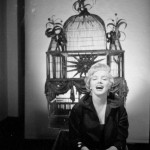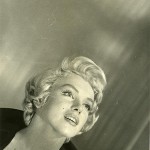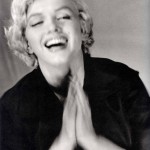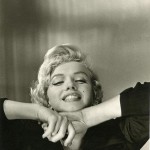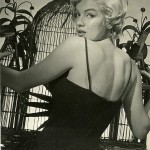1954
LIFE
The Hollywood actress and socialite turned photographer, Jean Howard, was born Ernestine Hill in Dallas, Texas, on October 13, 1910. As a teenager, she visited the studio of photographer Paul Mahoney. He encouraged her to take modelling work and she even used his surname.
In the late 1920s, Ernestine visited Hollywood with her father. Soon after, she returned. The Mahoneys had booked her into the Studio Club, a hostel for young actresses. She got her “big break” when Samuel Goldwyn placed her in Busby Berkley’s first musical, ‘Whoopee’, alongside a 14 year-old Betty Grable.
She then travelled to New York and performed in Florenz Ziegfeld’s final Broadway show, ‘Hot-Cha’. “The Ziegfeld showgirl was presented as the glorification of all that was graceful and beautiful in American womanhood,” she recalled. “If she had a come-hither sexuality tempered by aloofness that sparked across the footlights, she was the Ziegfeld ideal. It wasn’t easy!”After ‘Hot-Cha’ folded, Ernestine returned to Hollywood. She was signed to MGM, and adopted the more fashionable name of Jean Howard. She played minor, sometimes uncredited roles in a handful of movies, including ‘Dancing Lady’ (1933), featuring Clark Gable and Joan Crawford; and ‘Break of Hearts’ (1936), starring Katharine Hepburn. She also modelled for some of the era’s great portrait photographers: George Hurrell, Clarence Sinclair Bull and Russell Ball.
JEAN HOWARD’S HOLLYWOOD
In 1933, Jean Howard was spotted by Charles Feldman, president of the leading talent agency, Famous Artists, at a tea dance in the Beverly Wilshire Hotel. He sent her flowers, but she was unimpressed. “When I asked who Charles Feldman was and was told he was an agent,” she explained, “all I could visualise was an unattractive little guy, the stereotype of what every fast-talking agent supposedly looks like.”
When they finally met, Jean recalled, it was love at first sight. They married in 1934, and her career took a backseat thereafter. “It turned out that living was more important than acting to me,” she wrote in her 1989 book, ‘Jean Howard’s Hollywood.’“If you were new to Hollywood in the 1930s as I was, you heard about the great days of the 1920s,” she reflected later. “The forties crowd lamented the golden thirties…and it continues on today as generation after generation sees the past through tinted glasses.”
One of Jean’s first ventures into photography was at a lavish party at San Simeon, home of press magnate William Randolph Hearst and his girlfriend, actress Marion Davies. Jean developed a close friendship with songwriter Cole Porter and his wife, Linda, who mentored her in the lifestyle of a “Hollywood wife.”
Douglas Martin wrote in the ‘New York Times’, “The book evokes a lost world where stars lived lives that were breathtakingly glamorous, but still somehow life-sized… In the pictures, everyone, it seems, is smoking. Everyone is holding a drink, everyone is dressed in black tie or cocktail dress. People gather around the piano and sing. Conga lines end up in swimming pools…”By the early 1940s, Charles Feldman had branched out into movie production with a Marlene Dietrich vehicle, ‘The Lady Is Willing.’ Meanwhile, Jean joined the war effort and went on the road, photographing stars like Jack Benny, Claudette Colbert and George Burns on the Hollywood Victory Caravan for Army and Navy Relief. “To see movie stars, many of whom were not exactly at ease with public appearances and variety-show performances, live in a cross-country tour proved to be a moving experience for the audiences,” Jean remembered.
In 1944, Jean was introduced to a graphologist, Hilde Berle, who encouraged her to study photography at the Los Angeles Art Center. “Despite my protestations of being stupid about all that mechanical stuff,” Jean wrote, “Hilde said quite firmly, ‘It’s a school, they teach you those things.’”
Jean didn’t need to look far for inspiration, as some of Hollywood’s most glittering parties were hosted in her own garden at Coldwater Canyon, Beverly Hills. In 1946, she travelled to the Palm Springs estate of Darryl F. Zanuck, head of Twentieth Century-Fox, to photograph the first of many star-studded croquet tournaments in a lucrative assignment for ‘Life’ magazine.“Now Darryl, avid sportsman and hard-driven competitor in all things he touched, became a master of the game, which by the way is no child’s diversion,” Jean observed, noting his “ever-present cigar.”
Among the other contestants were director, Howard Hawks; actors Joseph Cotten and William Powell; and the songwriter, Hoagy Carmichael. Watching the match was RKO mogul, Howard Hughes, who was seriously injured when his private plane crashed just a day later.
By then, Jean had divorced Charles Feldman – but they continued living together until his death in 1968. They called it their “can’t live with you, can’t live without you post-marital relationship.” In a 1989 interview, Jean said she “wanted to be the other woman in his life.”
“After World War II a still-devastated Europe became a traveller’s playground, and a mass of exodus from Hollywood began,” Jean wrote. She and Charles headed for Rome with Darryl F. Zanuck and his confidant, the hostess and writer Elsa Maxwell, among others.
“Darryl was a sunbathing fanatic and, unlike other meaty moguls, had the kind of tight but lithe body made for a bikini,” Jean recalled. He picked up several exotic beauties while on his travels, some of whom he tried to promote with varying degrees of success. While in Europe, Jean photographed Orson Welles on a film set, and the lavish wedding of Tyrone Power and Linda Christian. She accompanied Rita Hayworth on a boating trip, shortly before her marriage to Aly Khan, and captured Ginger Rogers at the Shinnecock Hills Golf Club in Southampton, New York.
‘GLAMOUR IS FLIMSY’
In 1950, a twenty-three year-old Marilyn Monroe was signed to the William Morris Agency by another powerful agent, Johnny Hyde. That year, she won minor, but significant roles in two acclaimed movies, ‘The Asphalt Jungle’ and ‘All About Eve.’Charles Feldman, a friend of Hyde, had continued to produce movies, including the western, ‘Red River’ and Orson Welles’ ‘Macbeth’ (both 1948.) In 1950, he produced the Oscar-winning adaptation of Tennessee Williams’ ‘A Streetcar Named Desire’, starring Vivien Leigh and Marlon Brando.
Johnny Hyde and Marilyn were among the guests at an early screening of ‘Streetcar’, where Monroe met Leigh and her husband, Sir Laurence Olivier. Such was Feldman’s stature in Hollywood, that he was photographed by Jean for ‘Life.’
“The first time I saw Marilyn Monroe was in my own garden,” Jean remembered. “I was leaving for a lunch date when I spotted her, a lonely little girl sitting by the pool doing nothing. I asked if she would like something to drink. She softly refused…”Billy Wilder and John Huston, who later directed some of Marilyn’s greatest films, posed together for Jean with Anatole Litvak (‘All This and Heaven Too’), and Huston’s then-wife, actress Evelyn Keyes.
Hyde managed to negotiate a seven-year contract at Twentieth Century-Fox for Marilyn. However, when Johnny died suddenly in December of 1950, she was devastated. Furthermore, Hyde’s colleagues at the William Morris Agency allegedly blamed Hyde’s death on his adulterous affair with Marilyn, though he had a history of heart problems.
Among the men who attempted to console Marilyn in early 1951 was Charles Feldman. She attended a party at Coldwater Canyon with her future husband, playwright Arthur Miller. Over the next few years, Feldman would handle her career though he never succeeded in signing her as his client.
Jean Howard attended an exhibitors’ preview of ‘Gentlemen Prefer Blondes’, and took a photograph of Marilyn onscreen, singing ‘Diamonds Are a Girl’s Best Friend’. Later that year, Jean photographed Marilyn in a red bathing suit on the set of ‘How to Marry a Millionaire’, as she posed for publicity stills with co-stars Lauren Bacall and Betty Grable.
“Realising that Bacall could not carry the film alone, Zanuck shrewdly conceived the teaming of Fox’s longtime box-office queen, Betty Grable, and the blonde of the hour, Marilyn Monroe, who turned out to be the blonde of that decade, maybe the blonde of the century,” Jean wrote, adding that “Betty took an almost motherly approach to Marilyn.”
Jean also photographed another rising star, James Dean, who was then making his screen début in ‘East of Eden’. She was reunited with the Oliviers in 1953, and the intimacy of her portrait gives no indication that Viven Leigh would soon suffer a nervous breakdown while filming ‘Elephant Walk’, in which she was subsequently replaced by Elizabeth Taylor.
In 1954, Charles Feldman secured a role for Marilyn in Billy Wilder’s ‘The Seven Year Itch’, which he also produced. “At last, after five years of skyrocketing promise, (MM) had made an important film with a major director,” Jean noted. “The respect she so longed for was at hand.”
That November, Wilder and Feldman threw a party for Marilyn at Romanoff’s Restaurant. The Zanucks, the Goldwyns, and the Warners were all invited, as were stars like Humphrey Bogart, Groucho Marx, and Susan Hayward. Jean’s photo of Monroe dancing with her idol, Clark Gable, was published in a feature headlined, ‘LIFE Goes to a Party’.
“It was the first time Marilyn and Clark Gable had met,” Jean recalled, “and LIFE wrote that the King had danced with the new princess of Hollywood. She even asked for his autograph. When they got up to dance, I borrowed Sam Shaw’s camera and snapped this fleeting moment of mutual admiration.”
At around this time, Jean also held a formal photo session with Marilyn, of which two striking portraits survive.“She arrived an hour and a half late,” Jean wrote. “I had just about given up and started to take down the lights when she rushed in, breathless. Once we got going, Marilyn was as co-operative as any person I have ever photographed.”
For the first shot, Monroe wore a black cocktail dress. With her back to the camera, she held onto an ornate birdcage and glanced towards Jean. With its play of light and shadow, this portrait is like a scene from a film noir, with the lovely star imprisoned, and it seems to hint at the inner turmoil that lurked behind her golden image.
In a very different, slightly out-of-focus shot, Marilyn claps her hands together and laughs. The result is both natural and charming.
“First she eyed the birdcage that Tony Duquette had given me and simply found her own pose,” Jean explained. “But this was not exactly what I wanted. Although Marilyn had brought along that little tight-fitting, almost strapless dress that she called her ‘lucky dress’, I wanted to get away from the stereotyped, sexy shot that I had seen so often. We looked in my closet and came out with my favourite Hattie Carnegie black taffeta jacket. In the photograph that followed, I found the true spirit and soul of that beautiful, gifted girl.”
“Some time later,” Jean continued, “at a party at Gloria Vanderbilt’s, Marilyn appeared. In her sweet, soft way, she said something that startled me and I’m certain the others: ‘Jean took the best pictures of me I’ve ever had.’”
“She didn’t know who she was or who she belonged to,” Jean concluded in 1989. “The marriages never gave her anything to go on. There was the ballplayer (Joe DiMaggio) and Arthur Miller. Miller was a very good writer and all of that, but I have never seen him in anybody’s living room, and I have been in a few living rooms.”
‘I NEVER HAD A PAPARAZZI MENTALITY’
Jean also photographed other screen goddesses, including Grace Kelly and Audrey Hepburn; Hildegarde Knef, who came to Hollywood at the same time as Marilyn; Monroe’s favourite actor, Marlon Brando; cameraman Leon Shamroy, who shot her first screen test; and one of her least favourite directors, Otto Preminger.
She chronicled the ongoing party scene, capturing Joseph and Rose Kennedy in Palm Beach, as well as songwriter Irving Berlin and movie mogul Joe Schenck. She captured the moment when Sammy Davis Jr sang at a Hollywood party, admitting, “This was the first time I ever saw a black performer at a private social gathering in someone’s living room in Beverly Hills.”
By 1956, Darryl F. Zanuck had taken a backseat at Fox to focus on independent film production in Europe. Though Marilyn Monroe became the studio’s greatest star, he later acknowledged, “Nobody discovered her. She earned her own way to stardom.”
In 1957, Jean was asked to cover a recording session by Frank Sinatra in Las Vegas. He took her to dinner beforehand and showered her with roses. “As would any woman, I was wondering how this attention would end,” she wrote. “As we approached my place, I began to agonise about whether I should ask him to come in for a drink. Before I knew it, Frank had pulled up at the bottom of my steps. He reached over me, opened the door, and said, ‘Good night, Miss Howard.’ ‘Night, Frank,’ I said, puzzled. I’m still puzzled by this clever charmer.”
Back home in Coldwater Canyon, the revels continued. “We tossed our share of parties,” Jean remembered, “and how I wish I had snapped away at each of them – rarely did anyone object!” She brought her camera to a celebration for Cole Porter in 1953.
That night, Richard Burton got drunk and began kissing everyone, including actor Clifton Webb, who later asked Jean to destroy the negatives. “I never had a paparazzi mentality, and I gave into my friend,” she explained. With the rise of “scandal sheets” like ‘Confidential’, however, the days when stars could let their hair down in private were drawing to a close.
In 1960, Jean covered the Democratic Convention in Los Angeles, where John F. Kennedy won the presidential nomination. She later said that not photographing him was her greatest regret. But in 1993, she revealed that after everyone else left and she was cleaning up, Kennedy tapped on the window.
“I’m starving and nothing’s open at this hour,” Kennedy said. She led him to the kitchen and fed him scrambled eggs. She said the senator then pulled her to him and kissed her. She told ‘Town and Country’ magazine that people would have to read her autobiography to find out what happened. But she never published one.
By the early 1960s, Jean was spending most of her time in New York and Europe. “The Beverly Hills party scene had become a mix of the old guard and new faces, few of whom were as sparkling, sexy, or individual as their predecessors,” she admitted.
Among the few exceptions were Warren Beatty and Natalie Wood, with directors George Cukor and Henry Hathaway representing the elder generation. Jean also hosted party at her home for George Axelrod, screenwriter of ‘The Seven Year Itch’ and ‘Bus Stop’, in 1963, a year after Marilyn Monroe’s tragic death.
In 1964, Jean met musician Tony Santoro during a jaunt to the island of Capri. They lived together for nine years before marrying in 1973. Then in 1989, Rupert Allan – formerly a publicist to Marilyn Monroe – introduced Jean to a book editor, who persuaded her to publish her photographs. ‘Jean Howard’s Hollywood’ was followed by ‘Travels With Cole Porter’ in 1991.
Jean Howard died in her Beverly Hills home on March 20, 2000. She was 89. In an obituary for the ‘New York Times’, Douglas Martin wrote, “Jean Howard, who rode the comet of her extraordinary beauty, ethereal glamour and insouciant intelligence to become a Ziegfeld girl, a Hollywood starlet, a legendary hostess and the house photographer of the film colony… She thrived in a seemingly ancient time when stars socialized for purposes other than publicity, including simply enjoying each other’s company.”
[/vc_column_text][/vc_column][/vc_row][vc_row][vc_column width=”1/1″][vc_column_text]

